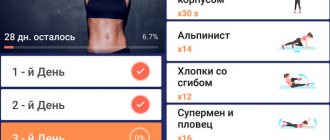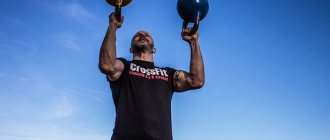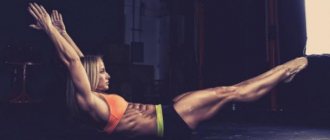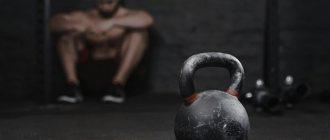What is CrossFit and what is it eaten with?
CrossFit as a form of physical activity appeared about 20 years ago in the United States of America and quickly gained popularity.
He came to Russia at the end of the 2000s. Many people have heard and know approximately what CrossFit is, but only in general terms. In this material we will talk in detail about all its intricacies, pros and cons, show the most popular exercises for beginners and give general training recommendations.
What is CrossFit, history of its appearance
CrossFit in English consists of two words:
- Cross – to cross, force;
- Fit – fitness.
Literally translated into Russian as intense fitness. CrossFit includes a system of high-intensity training, which is based on the following disciplines:
- Weightlifting;
- Weight-lifting;
- Gymnastics;
- Aerobics;
- Strongman exercises, etc.
Competitions are held in the CrossFit discipline, covering the whole world, including our country. And the Crossfit trademark was invented and registered in 2000 in the USA, where Greg Glassman and Lauren Jenai decided to create a large fitness empire and called it “CrossFit Inc.”
CrossFit is similar to regular circuit training - the exercises are constantly repeated, and to successfully complete it you need to complete a certain number of circles.
This type of training lasts from 15 to 60 minutes and not everyone is able to withstand it. The main goal of CrossFit is the comprehensive strengthening of the human body. It is popular in law enforcement units, combat sports and other areas of activity where the highest level of physical fitness is required.
Let's take a closer look at the elements and features of CrossFit.
Who is CrossFit for?
If your main goal is the harmonious development of your body, then CrossFit will definitely suit you. In the following cases, CrossFit will also be useful:
- Do you want to seriously pump up and get your body in shape;
- You love to compete, surpass yourself and get ahead of others. CrossFit as a team sport is popular in many countries around the world;
- Love sports and want to exercise every day;
- Many former professional athletes have switched to CrossFit and are trying themselves in this discipline;
- You've never played sports before, but you're serious about starting. A beginner in CrossFit can quickly become an amateur athlete, but before starting classes it is better to consult with a professional coach or instructor;
- You are a strong and purposeful person, you want to try and learn something new. CrossFit is a unique opportunity to improve yourself from both a physical and psychological point of view.
CrossFit is a universal thing, suitable for both men and women, both professional athletes and beginners or amateurs. The difference in training will only be in their intensity and working weights.
Also, if a person cannot perform an exercise, a replacement can be found. The better prepared the athlete, the higher the intensity of CrossFit training should be.
Let's look at the pros and cons of discipline.
Shock load
In CrossFit, the speed of performing a set of various types of exercises in a certain time is important, most of which are weightlifting. This builds strength endurance. But this is only the case when you do the exercise correctly and safely. These same bodybuilders are very rare visitors to me as a chiropractor. The reason is that these guys, when performing their exercises, form the correct so-called motor pattern. That is, with the constant execution of a movement of the same type, the automaticity of this movement is gradually developed at the reflex level. If you do the movements correctly, then the correct pattern is formed, which will not allow you to get injured, excluding force majeure under extreme loads, especially in competitions.
And if an athlete strives to complete the complex at maximum speed, most often he significantly neglects the technique of performing the exercises themselves. Moreover, strength exercises are “mixed” with endurance exercises and exercises related to stretching. It turns out that after performing a row or a burpee, where the spine is stretched, the pulse and heart pressure rise, the crossfitter rushes towards the bar... Uneven jerks, the bar goes sideways, the bar falls back, twisting the arms, the legs stand at different angles, then again the wrong performing backs, then jerking pull-ups with swinging, hard lifting of weights like the “Atlas stone”, incorrect jumps on and off pedestals, and so on... This is CrossFit, baby!
Under such loads, especially constant ones, the shoulder joints suffer first of all - so-called impingement syndromes are formed, in which the rotator cuff and intervertebral discs suffer, which, receiving colossal compression when performing weightlifting exercises incorrectly, and even extended over time, lead to the appearance of intervertebral hernias.
From sharp squats and subsequent quick lifts with a barbell, the menisci and cruciate ligaments of the knee joints are injured. The wrist joints really don’t like it when they are first pulled to break when lifting the barbell to the chest, and then the barbell falls back on them, which are at an unphysiological angle.
The same weightlifters, before approaching this barbell, will think through all their actions five times, will control every muscle, every ligament... A crossfitter does not have such an opportunity - he has time pressure. Only forward! But fast!
But treating joints is a rather lengthy and complex matter. But athletes are sometimes worse than children. That is, they don’t listen either, but they’re big and figure everything out themselves. They are treated poorly, most often symptomatically, and go back to training as soon as it gets a little better, forming persistent chronic inflammatory diseases, both in the spine and in the joints themselves, and then in the tissues surrounding them. These are common problems of CrossFitters, so to speak, without dividing them into gender characteristics.
Pros and cons of CrossFit
Pros:
- The cardiovascular system is well pumped;
- Increases endurance;
- All muscle groups are comprehensively pumped during training;
- Metabolic processes improve;
- Sleep improves, you feel fresh and full of energy;
- Increases body flexibility and reduces the risk of injury;
- Combined with proper nutrition and a healthy lifestyle, CrossFit can be a quick option for losing weight;
- Many sports and strength qualities develop. After doing CrossFit regularly, you will be ready to run, jump, lift weights, etc.
Minuses:
- Since CrossFit is a universal thing, by doing it exclusively, you are unlikely to be the best in a certain discipline: run the fastest, jump higher than others, or lift the heaviest weights;
- CrossFit is quite dangerous because the level of intensity of training is often higher than in alternative sports. Follow the exercise technique to avoid injuries;
- The cardiovascular system is subjected to high load during CrossFit training, it is important not to overdo it;
A set of exercises for beginners
It is good because it gives a noticeable load on all muscle groups, but does not have a negative effect on the joints. We perform this complex for 20 minutes and without breaks between exercises.
Burpee
- From the “lying support” position, we perform push-ups, then we pull our legs to the body and sit down in a “crouching position.”
- From this position we jump out, straightening our body completely and clapping our hands above our heads.
We do it five times.
Photo: istockphoto.com
Push ups
- Lying position, hands positioned slightly below shoulder level.
- Lower your torso to such a level that your elbows are bent at a right angle.
- Then we return to the starting position.
We do it 10 times.
Crunches
- We lie on our backs, legs bent and pulled towards the body, feet firmly resting on the floor.
- We raise our torso to our knees, trying to use the abdominal muscles and not help ourselves with our hands.
- Then we lower ourselves to the starting position.
We do it 15 times.
Squats
- Feet are shoulder-width apart, toes are turned slightly to the sides, arms are lowered along the body.
- From this position we lower ourselves down by bending our knees, while raising our straight arms and holding them in front of us.
- We lower ourselves deeply to form an acute angle in the knees. At the same time, keep your back straight and don’t lower your head.
We do it 20 times.
Photo: istockphoto.com
Jumping Jack
- We stand straight, legs together, and arms along the body.
- Then we jump, spreading our legs to the sides and clapping overhead while jumping.
- With the second jump we return to the starting position.
We do it 25 times.
Contraindications to CrossFit
There are many contraindications for every sport. Before starting training, it is highly recommended to visit a specialist doctor who is familiar with your sores and can advise and warn against troubles.
Contraindications:
- Injuries of the musculoskeletal system;
- Problems with the central nervous system;
- Diseases of the cardiovascular system;
- Digestive problems;
- Infectious diseases;
- Diseases of the genitourinary system;
- Contraindicated for women during pregnancy and lactation.
Even if you don’t have any ailments for which CrossFit is contraindicated, this does not mean that your body will immediately be able to withstand enormous loads.
If you decide to practice for the first time, the advice and supervision of a professional is simply necessary. Create a training program, learn the technique of performing basic exercises. Gradually increase the load over time. Only in this case can you avoid injuries and illnesses.
CrossFit training programs for men at home
We have prepared for you several effective training programs for men for different occasions. What they all have in common is that they are suitable for practicing at home. There will be 2 programs in total:
- If you are limited in sports equipment, that is, you do not have sports equipment from the list above (even weights and dumbbells).
- Training program with all the necessary tools - horizontal bar, box, dumbbells, etc.
Attention! If you want to achieve serious athletic results in CrossFit, it is still important to stock up on equipment - at least a horizontal bar and weights!
Training program No. 1 (without sports equipment)
The first training program for men at home without special equipment.
Weeks 1 and 3
Class schedule for weeks 1 and 3. Be sure to monitor your progress - preferably in complexes where you need to do the more rounds, the better, try to increase the number of rounds from week to week.
| Day 1 | We work for 16 minutes (1 exercise every minute alternating, that is, 8 minutes for each):
Rest 2 minutes. The more rounds within 10 minutes, the better:
Upon completion of the complex, we do the bar 4 times for 1 minute each with rest intervals of 20 seconds. |
| Day 2 | Rest |
| Day 3 | Circuit training 30 minutes without rest (the more rounds the better):
|
| Day 4 | Rest |
| Day 5 | We work for 12 minutes (the more rounds, the better):
We work for 15 minutes (the more rounds, the better):
Upon completion of the complex, we do the bar 4 times for 1 minute each with rest intervals of 20 seconds. |
| Day 6 | Rest |
| Day 7 | Rest |
Weeks 2 and 4
We do the following complexes already in the 2nd and 4th weeks of our program:
| Day 1 | We work for 16 minutes (1 exercise per minute alternating, that is, 8 minutes for each):
We work for 15 minutes (the more rounds, the better):
|
| Day 2 | Rest |
| Day 3 | We work for 30 minutes (circuit training):
|
| Day 4 | Rest |
| Day 5 | We work until we complete the whole complex - we aim for 40-60 minutes:
|
| Day 6 | Rest |
| Day 7 | Rest |
Home training program No. 2
Let's move on to a more complete CrossFit training program at home. This time with sports equipment.
Weeks 1 and 3
| Day 1 | We work for 15 minutes (the more rounds, the better):
Rest 2 minutes. We work for 15 minutes (the more rounds, the better):
|
| Day 2 | Rest |
| Day 3 | We work for 12 minutes (1 exercise per minute alternating, that is, 6 minutes for each):
We work for 15 minutes (the more rounds, the better):
|
| Day 4 | Rest |
| Day 5 | It's time to get a little tougher. We will make the “Murph” complex in a home interpretation and a little shortened. We work until we complete the whole complex - we aim for 40-60 minutes:
|
| Day 6 | Rest |
| Day 7 | Rest |











